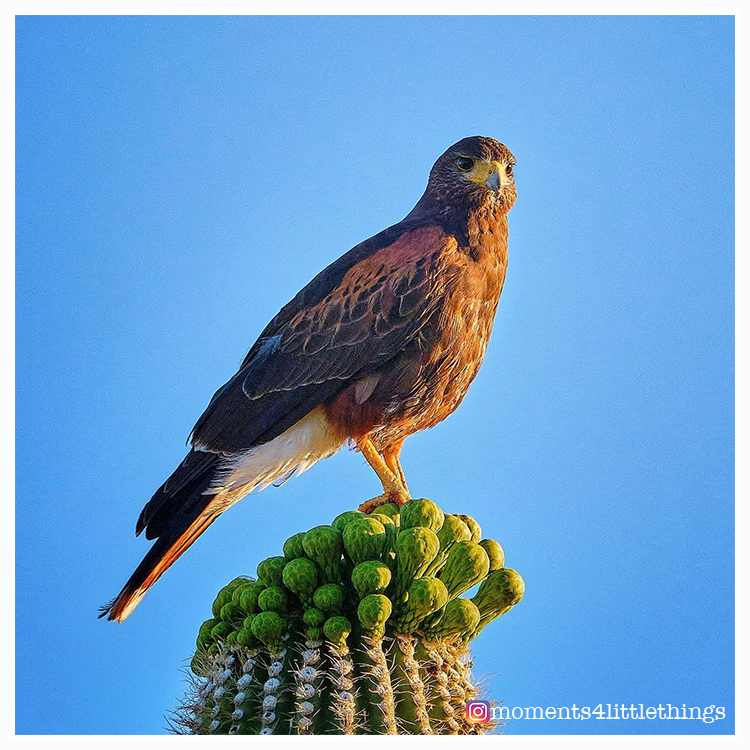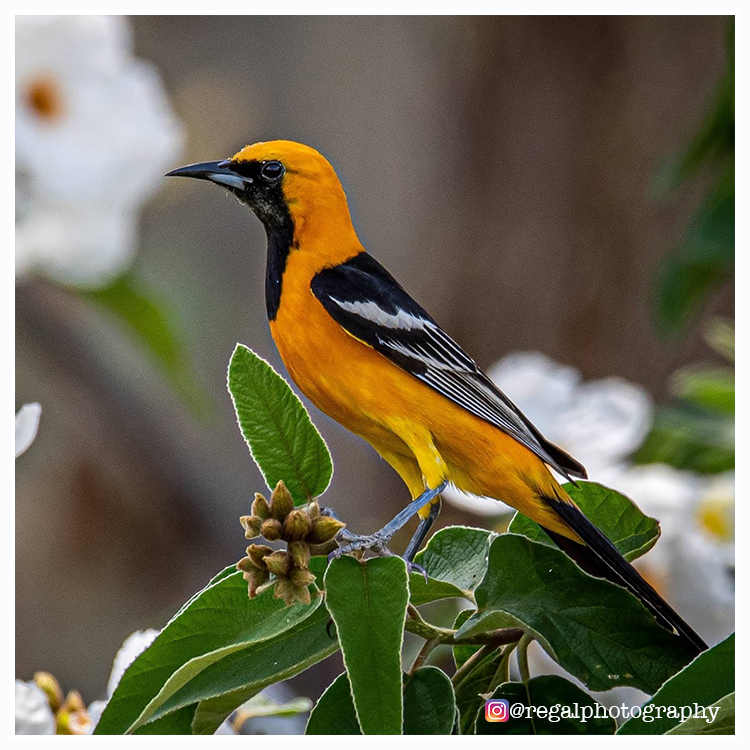A large variety of other interesting Arizona wildlife species can be found within the park and offer year-round wildlife viewing opportunities. Ranging from 4,600’ to 3,700’ in elevation, the landscape is dominated by rolling hills and panoramic vistas as it transitions from oak-woodland to desert grassland.
The most commonly sighted mammals include Coues white-tailed deer, coyote, bobcat, javelina, gray fox, cottontail rabbits, all four Arizona skunks (white-striped, spotted, hooded and hognose), many other small mammals, and an occasional mountain lion.
Common bird sightings include scrub jay, Gambel’s quail, raven, cardinal, great horned owl, cooper’s hawk, redtailed hawk, harris’s hawk, turkey vulture, gila woodpecker, say’s phoebe, curve-billed thrasher, hooded oriole, canyon towhee, phainopepla and many other seasonal migrants, including warblers, hummingbirds and sparrows.
Oracle also sits in the butterfly migration "superhighway" and experiences seasonal non-migrating butterfly population explosions as well. Here, Pipevine Swallowtail populations emerge from dormancy several times a year, and Painted Ladies pass through the park each year during their migration.
Reptiles include a variety of snakes and lizards featuring the western diamondback rattlesnake (pictured) and clark’s and desert spiny lizards, western fence lizard, giant spotted lizard and several others. The Gila monster and desert tortoise can also be seen.
Featured Springtime Birds
Harris's Hawk
 Most everybody likes big, impressive birds – especially raptors! Harris's Hawks, renowned for their impressive cooperative hunting strategies, are a prominent feature at Oracle State Park in Southern Arizona. In fact, these hawks use some of the most sophisticated cooperative hunting strategies known within the bird world! Their hunting prowess is on display to captivate park visitors! A hunt usually starts with an “assembly ceremony” where 3–9 birds assemble and perch together. Next, it gets interesting…to gain height and a more commanding view of the desert below, Harris’s hawks engage in an activity called backstanding. They literally stand on the back of other Harris’s hawks in stacks of up to four birds! It is believed that although these hawks range throughout open woodlands and savannas throughout Mexico and South America, the Sonoran Desert birds are the only Harris’s populations to hunt cooperatively.
Most everybody likes big, impressive birds – especially raptors! Harris's Hawks, renowned for their impressive cooperative hunting strategies, are a prominent feature at Oracle State Park in Southern Arizona. In fact, these hawks use some of the most sophisticated cooperative hunting strategies known within the bird world! Their hunting prowess is on display to captivate park visitors! A hunt usually starts with an “assembly ceremony” where 3–9 birds assemble and perch together. Next, it gets interesting…to gain height and a more commanding view of the desert below, Harris’s hawks engage in an activity called backstanding. They literally stand on the back of other Harris’s hawks in stacks of up to four birds! It is believed that although these hawks range throughout open woodlands and savannas throughout Mexico and South America, the Sonoran Desert birds are the only Harris’s populations to hunt cooperatively.
During a spring trip to Oracle, it’s typical to see Harris’s hawks hunting more often to feed their chicks. Nesting activity takes place November through January and the first clutches are laid January though March. Not surprisingly, these social hawks nest together in groups that include adults and immature birds.
Hooded Oriole
 You might think a bird as brightly colored as the hooded oriole would be easy to spot, but these birds can be surprisingly difficult to find despite being somewhat common at the park from April through August. To help locate them, listen for both males and females vocalizing with their complex song of sweet warbles and chatter, along with harsh chuck calls and the nasal wheet that sounds a bit like a House Finch. Although, hooded orioles are also known to mimic other birds, including Gila Woodpeckers and Ash-throated Flycatchers in Arizona which may make identification as complex as their song!
You might think a bird as brightly colored as the hooded oriole would be easy to spot, but these birds can be surprisingly difficult to find despite being somewhat common at the park from April through August. To help locate them, listen for both males and females vocalizing with their complex song of sweet warbles and chatter, along with harsh chuck calls and the nasal wheet that sounds a bit like a House Finch. Although, hooded orioles are also known to mimic other birds, including Gila Woodpeckers and Ash-throated Flycatchers in Arizona which may make identification as complex as their song!
Historically, hooded orioles have preferred to live and nest within cottonwood, willow, and sycamore trees (often associated with riparian areas) throughout the desert southwest. Despite their preferences, these beautiful birds have recently expanded into urban areas where they have found comfort and security amid ornamental palm trees.
The Big Stink

By Marlo Buchmann, Southern Region Interpretive Education Coordinator
Phew! What’s that smell? Just skunks. Mention the word “skunk” and right away we think of their smelly, defensive spray. But what else do we know about skunks?
Until recently skunks were members of the weasel family (Mustelidae) that also included weasels, ferrets, badgers and river otters. However, DNA studies show them to belong in their own family, Mephitidae. Skunks are found only in the New World. Arizona has four species of skunks. They are the striped, hooded, hog-nosed and spotted. The spotted is the smallest Arizona skunk species. Many other weasel family members also exude a foul-smelling musk, used mostly for marking territory.
Arizona has four species of skunks: striped, hooded, hog-nosed and spotted.
Skunks are mild-tempered and avoid confrontations unless provoked. When threatened, they usually turn to face the assailant, arch their backs, raise their tails, hiss and stamp their feet. If the warning is ignored, they turn their back to the intruder and discharge their musk. They can accurately hit a moving target at 15 feet, but the smell can carry for up to 20 miles! Now that’s a powerful stink!
The musk glands produce about a tablespoon of thick, yellowish, oily liquid, enough for multiple shots if needed. This mild poison can temporarily blind and incapacitate its victims, but causes no permanent damage. Skunks are about the size of a domestic cat, but have shorter legs that give them a waddling gait. Their musk glands are located at the base of their long, bushy tail. Their striking black-and-white fur serves as warning coloration against predators. Males are usually larger than the females.
Skunks are mostly carnivores, primarily eating small rodents, insects and grubs. Skunks will also eat bird eggs, reptiles, amphibians and mollusks. They are one of the only mammals that will eat honeybees. They supplement their carnivorous diet with grains and fruit.
Skunks are mostly nocturnal, but will forage during the day, especially when weather is cooler. Though they don’t hibernate like some animals, they sleep more in the winter by slightly slowing down their body processes. This requires greater amounts of energy than hibernation, so they often become active on warm days, foraging for goodies. In the wild they will den in an abandoned burrow or rock crevices; in civilization they will sometimes den under buildings.
The babies, or kits, are born blind, hairless and toothless in April or May. They grow rapidly and are independent in 10 weeks. Believe it on not, there are numerous predators that will eat skunks! Great horned owls, bobcats, mountain lions, coyotes and foxes will attack and eat skunks. Apparently the predators are pretty efficient (and have strong stomachs!), because skunks only live an average of 3 years in the wild. Skunks are notorious as carriers of rabies, second only behind raccoons.
If you encounter a skunk, move slowly and quietly out of its way. Remember, skunks usually only spray when confronted. So hopefully you now know more about skunks and their big stink.
P.S. And if you ever do get skunked, here's a a helpful deodorizer recipe:
Skunk Deodorizer Recipe
In a bucket mix:
- 1 quart of FRESH 3 percent hydrogen peroxide (available at drugstore or grocery store in the health care aisle)
- ¼ cup baking soda
- 1 teaspoon liquid dish soap (Dawn works best)
The mixture will bubble. Thoroughly wet the victim in the mixture, taking care to keep it out of the eyes. While it is bubbling, sponge on the mixture and wash in as if it were shampoo. Rinse and repeat. The solution must be mixed fresh each time it is needed. Discard unused portions. DO NOT place the solution in a closed container, as the bubbling would cause it to explode. It may affect the color of some fabrics and dogs!




